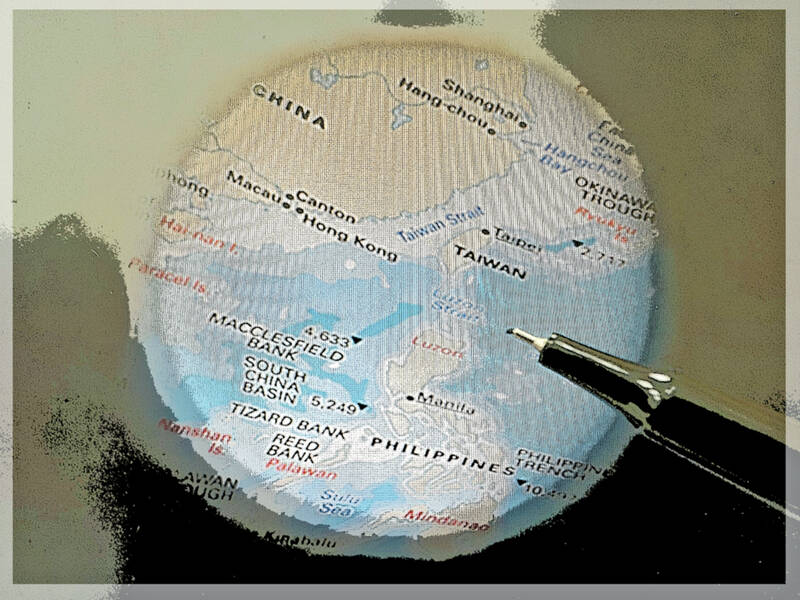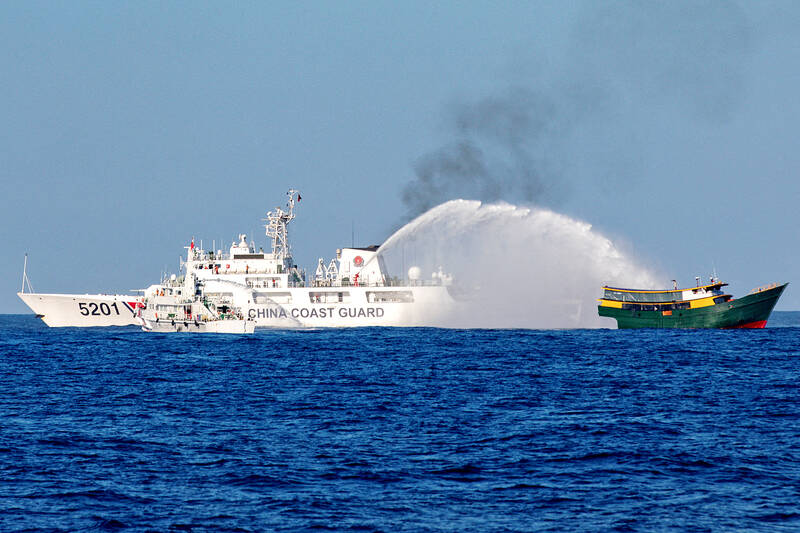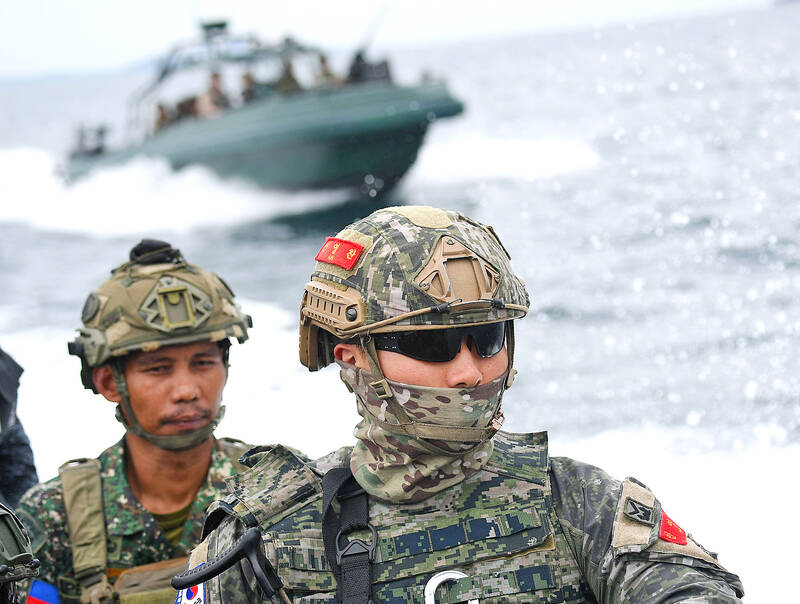Several recent articles have explored historical invasions of Taiwan, both real and planned, in order to examine what problems the People’s Republic of China (PRC) would encounter if it invaded. The military and geographic obstacles remain formidable.
Taiwan, though, is part of a larger package of issues created by the broad front of PRC expansion. That package also includes the Japanese islands of Okinawa and the Senkaku Islands, known in Taiwan as the Diaoyutai Islands (釣魚台), to the north, with the South China Sea and certain islands in the northern Philippines to the south.
THE DEBATE

GRAPHI: TT
Previous invasions of Taiwan make good objects of study and reflection, but a related, yet independent historical event that is also worth exploring for its capacity to shed light on a potential invasion is the debate among US policymakers during World War II over whether Formosa or the Philippines should be the priority objective of the US move into the western Pacific, the so-called “Luzon vs Formosa” debate.
By May of 1943, the US Joint Chiefs had developed a strategic plan for carrying the war to Japan. According to The Approach to the Philippines: The War in the Pacific, Robert Ross Smith’s excellent book on the invasion of the Philippines, “its underlying concepts governed the planning and execution of operations in the Pacific during a year and a half of debate.”
The plan was driven by the understanding that an invasion of Japan would probably be necessary, and that such an invasion would require bombardment from the air in preparation for the invasion.

Photo: Reuters
This led, by process of logic, to the necessity of securing a port and airbases somewhere in the “strategic triangle” formed by Luzon (the largest island in the Philippines), Formosa and southern China. That meant in turn securing bases south of that area to support the seizure of Formosa or Luzon.
As debates continued, it became obvious to the Joint Chiefs that Formosa was by far the best target. The leading proponent for prioritizing Formosa came from Admiral Ernest J King, Chief of Naval Operations and Navy member of the Joint Chiefs of Staff. Craig Symonds writes in World War II at Sea that “King believed that seizing Formosa would cut Japan off entirely from her essential imports and starve her into surrender, making an invasion of the home islands unnecessary.”
King also believed that US bases in Taiwan would strangle Japan’s bases to the south. In fact, by the summer of 1945 starvation was widespread among Japanese troops stationed on the Pacific Islands, cut off from the home islands by a submarine blockade.

Photo: AFP
The PRC must see the same thing today, looking at Taiwan’s position. Is the “core interest” they so often refer to Taiwan, or is it war against Japan? Or is it the strategic leverage of the Pacific Islands to the south that the PRC would gain from holding Taiwan? After all, Japan is the second largest trading partner of the Pacific Islands after the PRC, according to its Ministry of Foreign Affairs.
By contrast, famed army general Douglas MacArthur argued for the Philippines, contending that the US had a moral obligation to rescue it from Japanese rule, and that, more practically, bases in Luzon would be necessary to support a US invasion of Formosa.
FOOD BLOCKADE
A third, and minority, position called for bypassing both in favor of directly invading Japan (or Okinawa). MacArthur cogently argued that bypassing some part of the Philippines while leaving it under Japanese rule would be, in essence, a food blockade of parts of the Philippines not in Allied hands.
The food issue today receives much attention as it bears on both Taiwan and the PRC, but the Taiwan debate seldom considers Japan. Japan’s number one source of imported food is the PRC, while five of its remaining top 10 importers are in Asia. War would devastate Japan’s food security. Similarly, while one might think the Philippines, with its abundant agriculture, would be fine, it’s in fact a net agricultural importer. Indeed, in the last three years it has been the world’s largest importer of rice.
This means that, in the event of war, even if Taiwan maintained a lifeline to Luzon to transport food and munitions, that food would have to come from outside the Philippines. Sourcing foodstuffs locally would drive up prices (which are going to skyrocket in war anyway), starving the poor. Can the Philippines’s land communications and logistics handle the dual demand for food and munitions for Taiwan and for local needs?
Smith describes in his book how US planners eventually gave up on Formosa because it would have been far easier for Japan to bring in aircraft to contest the invasion, and to bring troops and planes across the narrow strait from China, which it occupied. Invading Formosa would also force the US to engage in a campaigns against Japanese bases in Amoy (Fujian) in China, with secondary invasions that would call not only for unacceptable levels of combat troops, but also for even larger numbers of service troops, which the US did not have. It would consume so many landing craft that it would have to be delayed until November of 1945, pushing back other much-needed campaigns (the availability of landing craft was a key determinant of US strategy in all theaters).
Finally, MacArthur said that the Navy’s fast carrier groups would be pinned to the Formosa theater for a long period while the island was taken, whereas carriers would only be needed for the initial move on the Philippines. Once bases in Luzon were acquired, they could be released for operations elsewhere.
By contrast, the Philippines would offer MacArthur tens of thousands of loyal Filipino troops to support the US war effort, something that did not exist on Formosa. Gradually, the momentum shifted to Luzon. By late 1944, according to Smith, King was nearly alone in his view that Formosa-Amoy would be better.
PRC CAPABILITIES
Much ink has been expended on PRC capabilities and that nation’s enormous navy. Does the PRC possess the skilled rear echelon support units that would be needed in abundance for simultaneous campaigns against Taiwan and against the islands supporting it? Indeed, as Smith writes, US planners eventually opted for the Philippines not because Luzon was the better strategic choice, but because the US did not have the resources for the Formosa-Amoy campaign. The US, alas, sorely lacked most of what it would need to sustain such a war.
The choices and combinations of Luzon vs Formosa vs Okinawa vs Japan, the first island chain, are mirrored in PRC military planning today. Surely there must be PRC planners arguing that it will need to take Luzon or an island in the strait between Luzon and Taiwan, to secure the southern flank. As I have noted many times in this column, Beijing’s public interest in northern Luzon goes back many years. Hence, PRC gray zone operations against the Philippines in the South China Sea should be viewed as practice, and as tests of Manila for such operations.
Notes from Central Taiwan is a column written by long-term resident Michael Turton, who provides incisive commentary informed by three decades of living in and writing about his adoptive country. The views expressed here are his own.

The Taipei Times last week reported that the rising share of seniors in the population is reshaping the nation’s housing markets. According to data from the Ministry of the Interior, about 850,000 residences were occupied by elderly people in the first quarter, including 655,000 that housed only one resident. H&B Realty chief researcher Jessica Hsu (徐佳馨), quoted in the article, said that there is rising demand for elderly-friendly housing, including units with elevators, barrier-free layouts and proximity to healthcare services. Hsu and others cited in the article highlighted the changing family residential dynamics, as children no longer live with parents,

It is jarring how differently Taiwan’s politics is portrayed in the international press compared to the local Chinese-language press. Viewed from abroad, Taiwan is seen as a geopolitical hotspot, or “The Most Dangerous Place on Earth,” as the Economist once blazoned across their cover. Meanwhile, tasked with facing down those existential threats, Taiwan’s leaders are dying their hair pink. These include former president Tsai Ing-wen (蔡英文), Vice President Hsiao Bi-khim (蕭美琴) and Kaohsiung Mayor Chen Chi-mai (陳其邁), among others. They are demonstrating what big fans they are of South Korean K-pop sensations Blackpink ahead of their concerts this weekend in Kaohsiung.

Taiwan is one of the world’s greatest per-capita consumers of seafood. Whereas the average human is thought to eat around 20kg of seafood per year, each Taiwanese gets through 27kg to 35kg of ocean delicacies annually, depending on which source you find most credible. Given the ubiquity of dishes like oyster omelet (蚵仔煎) and milkfish soup (虱目魚湯), the higher estimate may well be correct. By global standards, let alone local consumption patterns, I’m not much of a seafood fan. It’s not just a matter of taste, although that’s part of it. What I’ve read about the environmental impact of the

Oct 20 to Oct 26 After a day of fighting, the Japanese Army’s Second Division was resting when a curious delegation of two Scotsmen and 19 Taiwanese approached their camp. It was Oct. 20, 1895, and the troops had reached Taiye Village (太爺庄) in today’s Hunei District (湖內), Kaohsiung, just 10km away from their final target of Tainan. Led by Presbyterian missionaries Thomas Barclay and Duncan Ferguson, the group informed the Japanese that resistance leader Liu Yung-fu (劉永福) had fled to China the previous night, leaving his Black Flag Army fighters behind and the city in chaos. On behalf of the